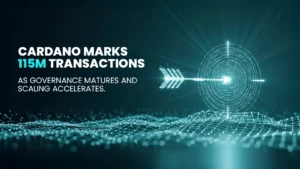Hoskinson Celebrates Historic SEC Staking Ruling, Reiterates ADA Staking Isn’t a Security

The U.S. Securities and Exchange Commission’s Division of Corporation Finance has stated that liquid staking activities, where users deposit crypto and receive staking receipts, are not considered securities. The overall crypto industry has welcomed the SEC’s staking ruling, but Cardano chief Charles Hoskinson took it a step further to reiterate that ADA staking wasn’t a security after all.
This important regulatory clarity comes as part of the SEC’s Project Crypto initiative aimed at modernizing oversight of blockchain‑based technologies.
The SEC’s staff emphasized that Liquid Staking involves staked crypto assets deposited with a provider that issues staking receipt tokens.
These tokens allow liquidity without relinquishing ownership. The Division’s view is that neither the staking receipts nor the staking process itself qualifies as securities under the Howey Test.
Hoskinson: ADA Staking Clearly Not a Security
Charles Hoskinson, founder and CEO of Input Output (Cardano’s development arm), quickly affirmed that ADA staking under Cardano’s Delegated Proof of Stake (DPoS) model remains distinct and free from securities classification.
ALSO READ: Swiss Banks Unlock Regulated Entry to SUI via DPoS, Spark a 4% Jump in SUI Price
He stressed that ADA staking is native to the blockchain’s consensus layer, where token holders delegate stake to pools without surrendering ownership.
He further noted that ADA staking does not meet the Howey Test: users are not investing in a joint enterprise nor relying on others to manage assets for profit. Instead, they actively participate in securing the network via Delegated Proof of Stake, maintaining control and autonomy throughout.
Native Staking Versus Liquid Staking Models
Cardano’s Delegated Proof of Stake system enables ADA holders to delegate tokens to staking pools, earn rewards, and retain the ability to withdraw or re-delegate at will.
This model, true to the principles of Delegated Proof of Stake, differs fundamentally from liquid staking services that rely on third-party intermediaries and issue receipt tokens or derivatives.
In contrast, liquid staking models involve external providers who pool user funds, govern the staking process, and issue staking receipt tokens that may represent the right to future returns.
ALSO READ: TRON Old-Timers Eject $1.4B as MERS Triples Bitcoin Pile via ARK ETF in a Key Retail Move
Such models raise questions under securities laws due to the potential for profit from the provider’s efforts, something the SEC guidance now says does not automatically render them securities, though the structure may require analysis.
Why This Matters for ADA Holders and Institutional Backers
Hoskinson’s declaration, in response to the SEC’s clarifying statement, underlines a regulatory advantage for ADA’s Delegated Proof of Stake approach.
By distinguishing Cardano’s native staking from liquid staking models, this clarity may reduce legal uncertainty for investors and institutional participants.
Greater confidence may encourage more widespread participation in ADA staking, enhancing network security and deepening Cardano’s appeal in the increasingly regulated crypto space.
ALSO READ: Cardano’s $71M Treasury Spend Kicks Off Historic Upgrade: Here’s Why It Matters
Conclusion
The SEC has clarified that liquid staking activities do not inherently constitute securities, a significant step in crypto regulation. Charles Hoskinson seized the moment to highlight that Cardano’s ADA staking via DPoS stands outside that concern, offering users full control, clarity under law, and continued participation in securing the network without regulatory complications.
Frequently Asked Questions (FAQs)
- What did the SEC make clear about liquid staking?
SEC’s Division of Corporation Finance said that liquid staking arrangements and staking receipt tokens are not automatically securities under existing law.
- Is Cardano’s staking distinct from liquid staking?
Cardano uses a Delegated Proof of Stake model where users delegate tokens directly in the consensus layer and retain ownership. Liquid staking involves third-party custody and receipt tokens.
- Why does Hoskinson say ADA staking isn’t a security?
He argues that ADA staking does not meet the Howey Test criteria; there is no investing in a common enterprise or reliance on others for profits. Instead, users actively contribute to network security via DPoS.
- What does it imply for ADA investors?
This clarity in regulation lessens legal uncertainty surrounding ADA staking, which may lead to wider adoption and institutional involvement.
- Will SEC guidance have international applicability?
This SEC opinion is applicable to the U.S. regulatory environment. Influential as it may be, it is not necessarily binding or reflective of other jurisdictions.
Glossary of Key Terms
- Delegated Proof of Stake (DPoS): A consensus model whereby token holders delegate tokens to validators in order to secure the network and receive rewards.
- Staking Receipt Tokens: Tokens issued by liquid staking providers representing a user’s staked assets and claim to rewards.
- Howey Test: A U.S. legal standard used to decide if a transaction is an investment contract (and hence a security).
- Liquid Staking: A form of staking where users stake via third-party services and acquire liquid representations of their stake.
- Consensus Layer: The part of a blockchain protocol responsible for validating transactions and securing the network.
- Project Crypto: The SEC’s undertaking to revise existing regulatory structures to better adapt to technologies underlying digital assets.




